- How much can you sue a company for in small claims?
- How much does suing a business in a California small claims court cost?
- What are the steps to suing a company in a California small claims court?
- What is a small claims court hearing like?
- Preparing to File Your Small Claims Lawsuit Against a Company
- How to find the correct legal entity name for a business you are suing
- Searching using the BBB (Better Business Bureau)
Contents
Ready to learn how to sue a company in a California small claims court? Learning how to sue a company in a California small claims court might seem like a complicated process but in this article, we break down how small claims works!
In this article learn about:
How much you can sue a company for in small claims.
How much going to small claims costs.
The steps to suing in a California small claims court.
What to expect during a small claims hearing.
What information you will need when preparing to file the small claims court lawsuit.
How to find the right legal name for a business you are suing.
How much can you sue a company for in small claims?
In California, you can sue a business for a maximum of $12,500 if you are an individual. If you are a business suing a business, you can sue for a maximum of $6,250.
Note, if you are a sole proprietor, you count as an individual.
By suing in small claims you are agreeing to waive any amount over the maximum amount you can sue for, even if you are owed more.
For example, if a business owes you $13,000, and you decide to sue in small claims, you are waiving suing for an additional $500. Meaning that you will win a maximum of $12,500.
While you may be missing out on the full amount you are owed, there are practical benefits to suing in small claims instead of suing in "regular court."
Here are some of the benefits:
Court filing fees are cheaper in small claims than in other courts.
The process is faster in small claims than in other courts as your hearing will usually be scheduled 30-70 days after you file the lawsuit.
Lawyers are generally not allowed in small claims which helps keep the costs of suing low.
How much does suing a business in a California small claims court cost?
So how much are you going to spend by suing in small claims court?
Court Filing Fees
The amount you will pay to file a small claims lawsuit in California depends on how much you are suing for. You will pay between $30 to $75 to file the lawsuit. If you cannot afford to pay court fees, you can ask the court to waive the fees.
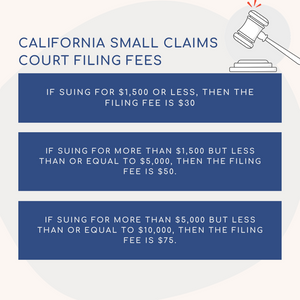
Serving Costs
Once the lawsuit is filed, you have to notify the company you sued that it has been sued. This is called "serving."
Serving Costs can range from $0-$75 per company you sue.
If you win, you can request that the company you sued pay for your court fees and serving costs.
Learn More: Full Guide on California Small Claims Court Filing Fees
What are the steps to suing a company in a California small claims court?
We have outlined each one of these steps in detail, click the links to learn more.
Prepare and file the lawsuit. Learn more.
Notify ("serve") the company you have sued. Learn more.
Prepare for and attend the small claims hearing. Learn more.
Once the lawsuit is filed, the small claims hearing will be scheduled 30-70 days later.
What is a small claims court hearing like?
Small claims hearings in California small claims are informal and most hearings last around 15 minutes.
Who will represent the company at the hearing?
The easiest way to answer this question is that a lawyer will not be representing the company since lawyers cannot represent parties at the initial small claims hearing.
If the company you are suing is a corporation or LLC, they will have a non-lawyer employee representing them at the hearing.
If the business is a sole proprietorship, meaning the business is not incorporated as a corporation or LLC, the owner of the company will represent the business at the hearing. It can be tricky to figure out when a business is a sole proprietorship, more on this in the section below on "fictitious business names."
If you and the company you sued, both show up:
Right before the hearing, the judge will ask you and the company representative to show each other the evidence that you will later show the judge.
The judge will ask you why you are suing.
The judge will ask the company to tell them their side of the story.
The hearing will last around 15 minutes.
The judge will ask you to show them the evidence you brought. Sometimes the judge will keep the evidence. Other times, you will get the evidence right back.
Very rarely a judge will tell you whether you won or lost at the hearing. Instead, the judge will tell you that their decision will be mailed to you (usually takes a few weeks to two months or so).
If you show up but the company you sued does not show up:
If the company you sued does not show up to the hearing but you properly notified ("served") them, then the hearing will still take place. You don't automatically win and will still have to tell the judge why you should win.
Learn More: What is What is a Small Claims Court Hearing Like?
Preparing to File Your Small Claims Lawsuit Against a Company
In order to sue a business in a California small claims court, you need to know:
The correct legal entity name for the business.
Who the "registered agent for service of process" is.
When filing a lawsuit against a company in a California small claims court, it is very important to write down the correct business entity on the lawsuit.
1. What does suing the "correct business entity" mean?
An example is the best way to explain this. Let's say you hired "ABC Painting" to paint your home. ABC Painting may be an individual (sole proprietor) doing business as ABC Painting or ABC Painting may be an LLC or Corporation. Companies sometimes use a name other than their real legal entity name when doing business. This is called a fictitious business name.
What happens if I don't sue the correct business entity?
If you win the lawsuit you will get a "judgment" against an individual or a business entity. If they don't pay the judgment, you may encounter problems enforcing the judgment if the wrong name is listed on the lawsuit.
Click here to learn more about collecting the judgment in California Small Claims Court.
2. Who is the "registered agent for service of process"?
Any corporation or LLC that does business in California, has to select a person (or another business) to receive legal documents (like a lawsuit) on their behalf.
This person (or business) is called the "registered agent for service of process" or just the "registered agent."
After the lawsuit is filed, this is the person (or business) who will be notified ("served") of the lawsuit on behalf of the company you are suing.
Read more below on how to find the registered agent.
Read More: Complete Guide on how to file a Small Claims Court Lawsuit in California
How to find the correct legal entity name for a business you are suing
Step 1: Make a list of any names the business has used in your interactions with them.
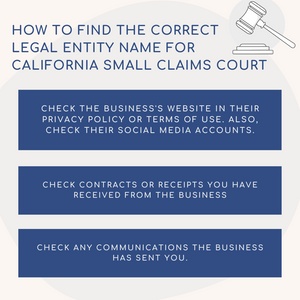
Check the business's website. Sometimes you can find the information in their "privacy policy" or "terms of use" all the way at the bottom of the website.
Check contracts or receipts you have received from the business.
Check any communications the business has sent you.
If the lawsuit involves a contractor or an auto repair shop, look up their business license.
Step 2: Check the California Secretary of State's website
Using the list of names you have created for the business, run a search on the California Secretary of State's website.
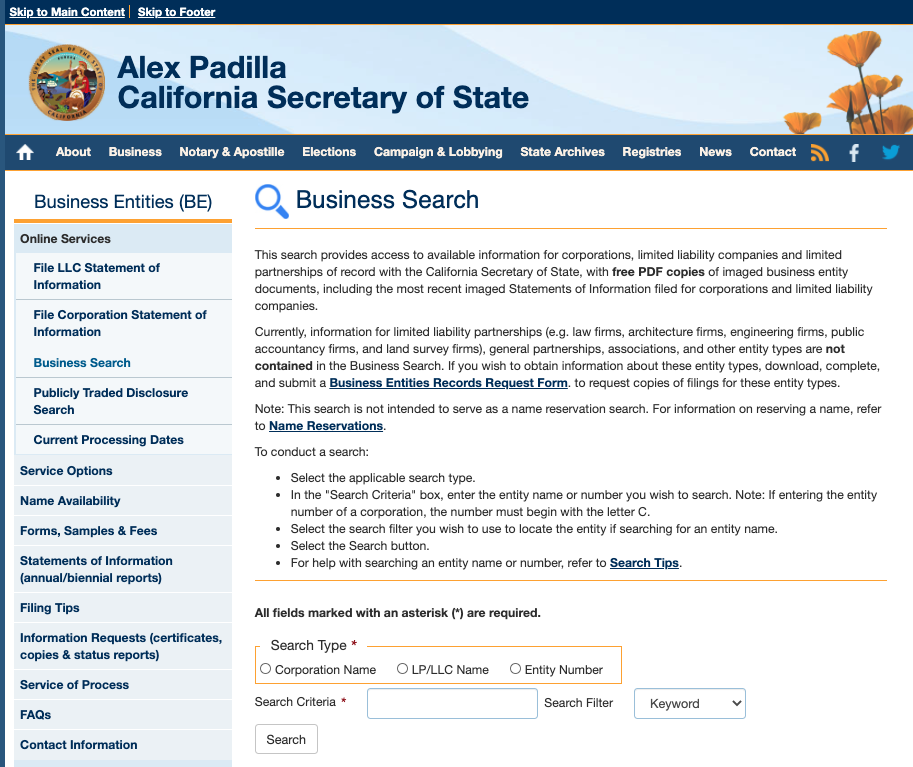
Here are some tips:
If you don't know whether the business is a corporation (the name will usually end in "inc." or have the word "corporation" in it) or LLC (the name will usually end with "LLC"), search by both categories.
If too many similar names come up, you may want to click on the word "status" so the results are organized by businesses with "active" status.
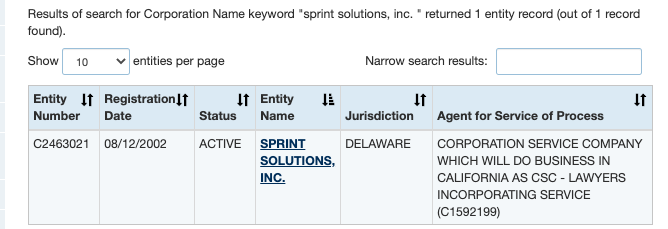
There are many businesses that have similar names so make sure the name you find is as close to one of the names listed on their website.
Make sure to also click on the name of the business under "entity name" and review the addresses. If the addresses are similar to the ones on the website, then you have likely found the correct business name.
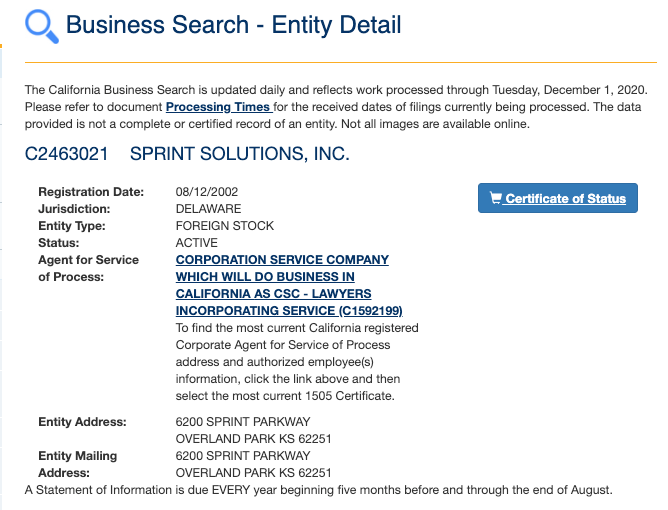
For example, if you were suing Sprint (the phone company) you would have to double-check that "Sprint Solutions, Inc." is the correct legal entity for Sprint (the phone company). Run a quick google search for "Sprint Solutions, Inc." and see if the information you find ties it to Sprint (the phone company) or whether it is a different company.
Make sure you write down:
The complete legal entity name for the business.
Who the "registered agent for service of process" is. This is the person (or business) who will be served on behalf of the business you are suing.
If no names come up, then run a fictitious business name search in the county where the business is located (Go to step 3).
Step 3: Determine whether the business is using a Fictitious Business Name
What is a Fictitious Business Name?
Sometimes an individual or business will operate using a name other than their legal name. This is known as a:
"fictitious business name"
"FBN"
"doing business as"
"DBA"
California law requires sole proprietors, partnerships, LLCs, and corporations that want to do business using a name other than their legal name to register the name in the county where their principal place of business is located.
The purpose of this is to ensure that when someone wants to sue a business, they are able to find the right person to sue.
Sole Proprietors
When a sole proprietorship or an individual uses any name that does not include the last name of the individual, they should file a Fictitious Business Name Statement.
A sole proprietorship is a business owned by 1 person (or a married couple). If a sole proprietorship does business using a name other than the owner's name, they must file a Fictitious Business Name Statement in the county where their principal place of business is located.
Note: If their principal place of business is located outside the state of California then they must file the fictitious business name statement in Sacramento County.
Partnerships
If a partnership wants to use a name that does not include the last name of each partner, they may need to register the name they are using.
Corporations
If a corporation uses any name other than the legal name stated in the articles of incorporation filed with the California Secretary of State, then they may need to register the name they are using.
For more information on Fictitious Business Names read the California Business and Professions Code Sections 17900-17930.
How to search for registered fictitious business names?
Each county has a database with the registered fictitious business names. If you determine that a corporation or LLC is using a fictitious business name, then go to Step 2 to search the California Secretary of State's database using the official legal entity name.
If you determine that an individual is using a fictitious business name, then you would list the individual as the defendant (person being sued) on the lawsuit.
Searching using the BBB (Better Business Bureau)
Still can't find the correct legal entity name? Another option is to search on the BBB. If the company has had complaints in the past, then the Better Business Bureau might have looked up the legal entity name.
How to find the right business name on the BBB
Type the business name. If you know the city and state where the business is located, then enter the city and state in the address box. Otherwise, leave it blank and press search.
A list of business names will come up. You may see a different business name than the one you typed. Try clicking on "view BBB review."
Go to the section labeled "Business Details." Determine whether it seems like that is the correct business you worked with by verifying the address. The business may list who the owner is or their correct legal entity name.
Learn More: 2024 Guide to Suing in California Small Claims Court

Camila Lopez, Esq.
Attorney at JusticeDirect. Camila holds a law degree and is a certified mediator. Her passion is breaking down complicated legal processes so that people without an attorney can get justice.

